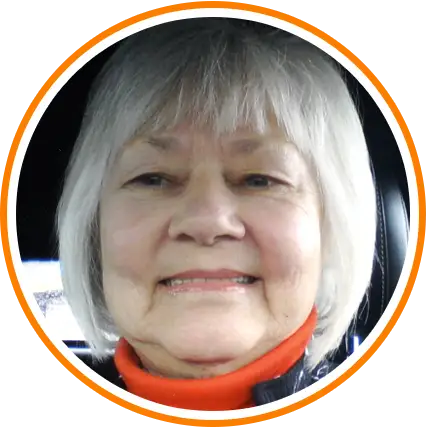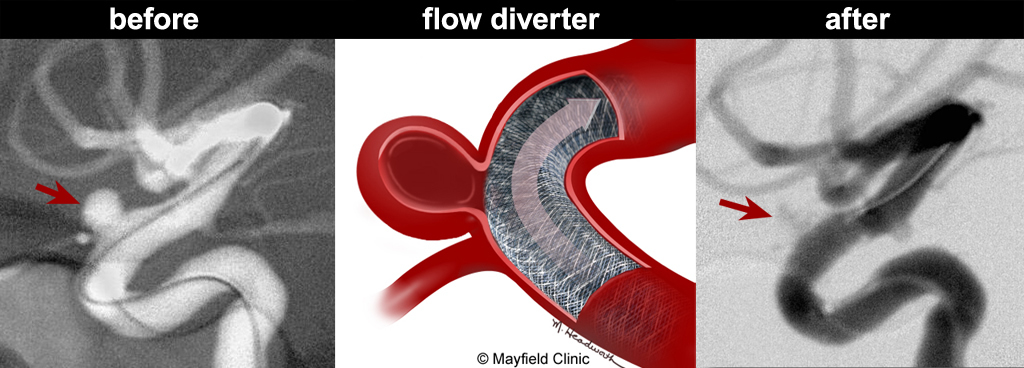 Virginia's story: triple trouble solved
Virginia's story: triple trouble solved
Brain aneurysms
Virginia never knew that she had a problem, let alone three problems. She was working at the job she loved when she was suddenly overcome by a fainting feeling. She didn’t pass out, but when her worried co-workers could not get her to "come back to reality," they called 9-1-1.
Virginia was whisked to the nearest emergency room, at Bethesda North Hospital. Doctors ordered an MRI and soon gave Virginia the news. They had found two aneurysms in her brain. An aneurysm is a balloon-like bulge or weakening in the wall of an artery. Virginia was transferred immediately to Good Samaritan Hospital, where Dr. Andrew Ringer of Mayfield Brain & Spine is Chief of Neurosciences. Before Virginia could see him, however, the hospital performed another MRI – and found a third brain aneurysm.
"I told them not to come to my room again unless they could bring me some good news," Virginia says with a laugh. Her situation was anything but a laughing matter, of course. She had two small aneurysms on the left side, and a larger aneurysm on the right. Virginia remembers that day as a blur. "It was a shock when they told me," she says.
Virginia spent the night in the hospital and then met with Dr. Ringer, a neurovascular specialist, to begin mapping out a plan. Aneurysms can be treated in several different ways, so the path forward was not definitive. "We had to decide which one to go after first, which one to focus on, and how to treat them," Virginia says.
Staring down her fears, Virginia, who was 68 at the time, told herself she would survive. "I had a grandson and family, and I wanted to be around to enjoy them. That meant a lot to me. I told myself, I’m going to fight for this. I’ll do whatever it takes."
Dr. Ringer decided to address the two smaller aneurysms first. Both were classic saccular, or "berry," aneurysms, with a neck that could be surgically clipped. Dr. Ringer’s recommendation was to create an opening in Virginia’s skull (a craniotomy) and place a metal clip over the neck of the two small aneurysms.
"The advantage of a clipping procedure is that it blocks blood flow into the aneurysm and is a permanent solution in more than 95 percent of cases," Dr. Ringer says. "The disadvantage is that it involves opening the skull and touching the patient’s brain." Virginia declined the craniotomy and clipping treatment. "I vetoed that," she says. "I asked him to give me another option. I figured with all the medical advances, there had to be another option."
Fortunately for Virginia, there was.
Dr. Ringer was able to offer a second choice: an endovascular (in-the-artery) procedure. He would insert a catheter in the groin and thread it up to the aneurysms in Virginia’s brain.

Dr. Ringer treated the first aneurysm at Good Samaritan Hospital, using a glue-like substance called Onyx to fill the aneurysm sac and block the blood flow into the aneurysm without interfering with the blood flow in the normal artery. "Not all aneurysms can be treated with a liquid agent, particularly if there are nearby normal artery branches into which the glue could leak," Dr. Ringer says. "Still, there are advantages to the liquid over more traditional endovascular options because the permanent cure rate is close to that of open surgery. Fortunately, Virginia’s largest and scariest aneurysm was a good candidate for the Onyx and was completely treated."
A few months later, also at Good Samaritan, Dr. Ringer treated the second aneurysm. This aneurysm, unlike the first, was close to a normal branch, so it could not be safely treated with Onyx. In this situation, doctors often fill an aneurysm with coils.

"Aneurysm coils are like tiny threads of platinum that, when placed inside an aneurysm sac, look much like a ball of yarn," Dr. Ringer explains. "While still a good way to treat an aneurysm without resorting to open brain surgery, coils may shift over time, allowing an aneurysm to regrow. Or the coils may migrate into the normal artery during placement."
To avoid this problem and to hold the coils in place, Dr. Ringer covered the opening into the aneurysm with a stent, which he likens to "a tube of chicken wire." For a second time, Virginia’s aneurysm was treated and prevented from growing.
The third aneurysm was the most complex. Dr. Ringer would treat this aneurysm with the new Pipeline stent. "This was the most novel of all the treatments available and was, at that time, only available in our region at University of Cincinnati Medical Center," Dr. Ringer says. "The Pipeline Embolic Device works on a unique principle of flow diversion."

The goal of the procedure was to place a tubular stent device in the normal artery, across the opening of the aneurysm, and to direct the blood flow down the normal artery while diverting it away from the aneurysm. Unlike the more traditional stent that Dr. Ringer used to treat Virginia’s second aneurysm, this stent had a consistency that was more like cheesecloth. "It is a finely woven material, and blood cannot easily get through the spaces," Dr. Ringer explains. "The tightly woven tube creates resistance to the blood flow, causing the blood to continue down the artery along the path of least resistance and in turn causing the aneurysm to eventually clot off, wither, and die."
The procedure went flawlessly. Virginia stayed in the hospital overnight and then went home.
During the next two years she had an angiogram every 6 months to ensure that no blood flow had returned to any of her aneurysms; now she is scheduled to have a simple MRI test called a magnetic resonance angiogram (MRA) every two years.
Virginia’s only risk factor for developing an aneurysm was a past history of smoking. Even so, she had not smoked in 14 years. No one in her family was known to have an aneurysm, and no one in her family had died of a stroke. "Life’s a big mystery, and you’re not promised a tomorrow," she reflects.
Virginia is back at her job three days a week and is enjoying time with her grandson.
"I’ve had no complications, no problems," Virginia says. "It’s like nothing ever happened. I owe my life to Dr. Ringer. I think without him I probably wouldn’t be here. I thought he did a remarkable job."
Her advice to other patients facing similar procedures is simple: "Don’t hesitate whatsoever, and don’t be afraid. It’s totally worth it. I would do it all over again in a heartbeat."
Hope Story Disclaimer -"Virginia's Story" is about one patient's health-care experience. Please bear in mind that because every patient is unique, individual patients may respond to treatment in different ways. Results are influenced by many factors and may vary from patient to patient.
